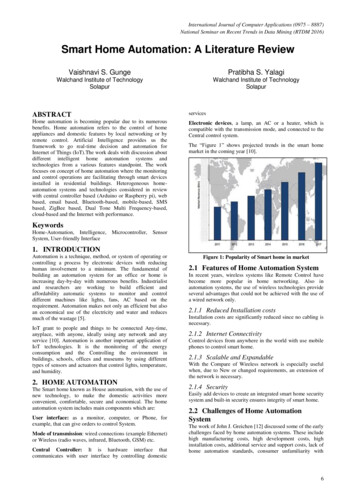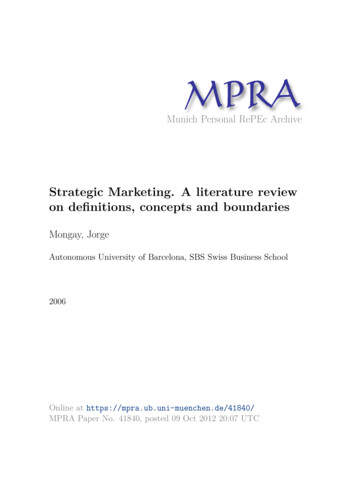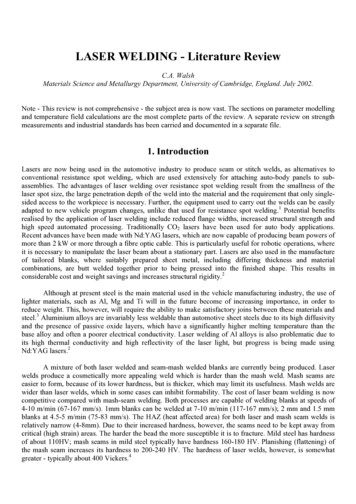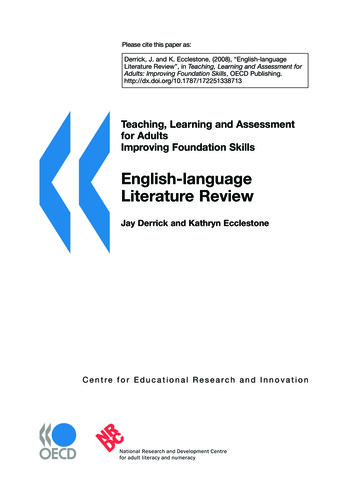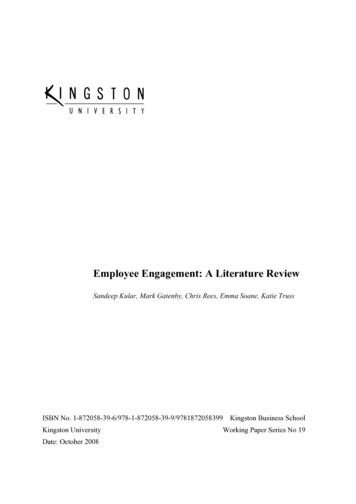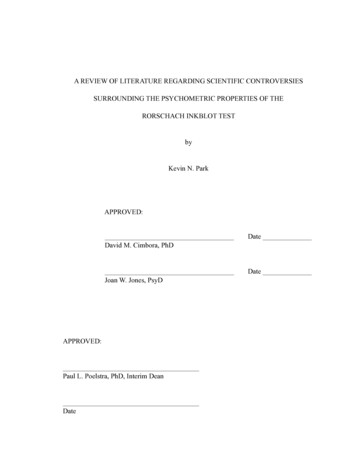
Transcription
Mayatra et al, International Journal of Advance Research, Ideas and Innovations in Technology(Volume 1, Issue 4)A literature review on implementation of LeanManufacturing TechniquesMehul Mayatra1, Mr. N.D. Chauhan2, Mr. Parthiv Trivedi31PG Student of SVBIT Gandhinagar23Principal of SVBIT GandhinagarAsst. prof. mechanical department SVBIT ugkv.ac.in3parthiv.trivedi@bapugkv.ac.inAbstract: In competitive environment lean manufacturing is necessary in every industry. Lean production is astandard manufacturing mode of the 21st century. Lean manufacturing have various synonyms like leanmanagement, lean production, It is very use full techniques for reduce the flow of non value added time. Leanmanufacturing is a philosophy to reduce the time between customer order and products are ready for thedelivery by eliminating waste. Waste (muda) is a serious problem in to the industry it is creates a non valueadded services and poor quality of the product. Waste are seven type occurs in industry 1) transport,2)inventory,3)motion,4) waiting,5) over production,6) over processing,7) defect. It is eliminate with the help oflean manufacturing. It is an integrated system that gives production of goods/services with minimum bufferingcosts. This paper gives the literature survey on various type of industry to apply the lean manufacturing, likeapply in to automobile industry, and pharmaceutical company, cotton seed oil industry, health care hospital. Andalso refers other 5 papers gives the information about lean manufacturing and discussion. And introducing aboutlean .what is lean manufacturing, why it is needed, and method of lean manufacturing that reduces waste. Andalso to introduces about different lean tools.Keywords: lean manufacturing, kaizen, kanban, JIT, VSM, 5sI. INTRODUCTIONThe term lean production was first used by Krafcik (1988) and it was drawn from the famous book titled TheMachine that Changed the World: The Story of Lean Production (Womack et al., 1990).[9] Lean production isrooted in the Toyota production system and primarily aims at the elimination of waste (muda). Taiichi Ohnodefined “muda” as any human activity, which absorbs resources but creates no value. Lean manufacturing isdefect reduction and inventory control, reduce lead time, and change over time, Lean production using half ofthe human effort in the factory,[15] Lean manufacturing is flexible manufacturing techniques. And reduce the50% of human efforts.Lean manufacturing tools:
There are various type of lean tools are available and use this tools and principal, like cellular manufacturing,JIT, continuous improvement, production smoothing, standardization of work, total productivemaintenance(TPM), SMED, etc. We are understood about lean tool one by one in shortly.Cellular manufacturing:Cellular manufacturing reduce the transportation waste. And reduce the inventory. Cellular manufacturingalso says “one piece flow” process. It is difficult to fulfill the customer requirement with traditional productline, so using the U- shape product line replace traditional product line.[15]Just in time (JIT):Just in time is a heart of the lean manufacturing. It’s associated with lean techniques. Just in time productiongives right part at the right place at right time.Kanban system, Production smoothing, and setup time reduction are component of any JIT system. “kanban”is a Japanies word which means card or signal. Which process is running and give the basic information aboutmanufacturing.There are two types of kanban. Single Card Kanban System and Double Card Kanban SystemSingle Card Kanban System: In a single card kanban system parts are produced and brought according to adaily schedule and deliveries to the user are controlled by c- kanban.Double card kanban system:C- kanban andP- kanban.C- kanban: Gives signal for deliver more parts to the next process.P- kanban: Gives the signal for require more parts.[15]Production Smoothing: Production smoothing is the process of the balance the work load over different timeperiod. It provide flexibility to respond rush order.[18] it is help to eliminate over production.Total productive maintenance (TPM): Total productive maintenance is the techniques for reducing themachine down time and eliminates the defect and scrap. TPM is a fundamental pillar of lean. It is introducingawareness of self maintenance and also introducing the preventive maintenance of machine. [13]Continuous Improvement: Continuous improvement such as improve the quality of product and customersatisfaction. Kaizen and 5s are the component of continuous improvement.Kaizen: Kaizen is a Japanese word kai means continuous and zen means improvement, so its Englishtranslation is continuous improvement. Its main focus on completely improve the product and satisfy thecustomer.5s : It has a five stage of the improvement of the process. It has five “S” all “S” gives the different meaningand activity. Seiri, Seiton, Seiso, Seiketsu, and Shitsuke. Is a Japanese word and translate into English These5S is: Sort, Set (in place), Shine, Standardize, and Sustain.[7]First ‘S’Second ‘S’Third ‘S’Forth ‘S’Fifth ‘S’SeirySeitonSeisoSeiketsushitshukeTable I: For the 5s detail. [7]sortSorting out of the necessary parts.SetAll the parts arrange of its properplace.ShineAll working area keep cleanStandardizeIt is standardize clean upSustainKeep discipline
Value stream mapping: Value stream mapping(VSM) is a paper pencil tool it is identify the value of addedand non added. Its is visual representation of material flow and information flow. Value stream mappingcreates a two maps starting with current state map it gives the snapshot of assembly which process running.And after second one is create a future state map for the improvement of the process.[13]What is lean manufacturing?Lean manufacturing is a system that integrates the daily work of producing and delivering products, services,and information of the problem identification and process improvement to eliminate waste and reduceproduction lot sizes.[19]Lean manufacturing is the main aim of the high quality, low cost, and just in time delivery by shortening theproduction flow by eliminating waste. Lean manufacturing is a team base structure. It breaks downorganizational barrier and develops highly trained and motivated employees who investigate problems andfind solutions as a part of their job.[19]Lean manufacturing is an integrated socio technical system whose main objective is to eliminate waste byconcurrently reducing and minimizing supplier, customer, and internal variability.[13]Why it’s needed:In today’s competition is very increase in business. And customers are more and more aspect for the quality inproduct so that, standing with other competitors; it is needed to implement the lean manufacturing technique.Because it’s give the better quality of product and customer satisfaction. Without any investment and Also it’sexcess of inventory and reduce the cost or non value added activity with the help various lean tools, leanmanufacturing also reduce the seven type waste occurring in industry. Like (1) Transport (2) Inventory (3)Motion (4) waiting (5) over processing(6)Over production (7) Defect. It is reducing with the help of variouslean tools and principal are listed following.5s, OEE (over all equipment effectiveness), 8 step practical problem solving (PPS),Pareto analysis,elimination of waste, kaizen, setup time reduction, process mapping, value stream mapping(VSM), quick andeasy kaizen, SPC/control charting, 5 why, autonomation, continuous improvement, continuous flow, visualcontrol, design for six sigma(DFSS), cellular manufacturing, production leveling, kanban, line balancing,voice of the customer, Jidoka, Anova, Work standardization, work simplification, fish born diagram, sixsigma, takt time, pokayoke/ mistake proofing, it is all lean tools are depend on the industry and industryproblem which tools are apply and get a maximum benefits.[7]Method of lean manufacturing:Method for lean manufacturing is implementation in industry consider some steps are to be taken asfollowing.(1)Select the target or product.(2)Gemba walk, for the collecting data and all the data from product line and industry(3)Prepare a chart or map for the analyzing data and take decision where is the maximum waste or nonvalue added flow, with the help measuring lead time, cycle time, number of workers, and inventory, we arealso used the current state map method from VSM.(4)And after completely understand about the waste or non value added, so that decide the lean toolswhich lean tools apply and give maximum result, Depend on the waste. like tools are 5s- for the decrease thewaiting time, cellular manufacturing focus on industry, SMED- reduce the time consuming by change overtime and setup. JIDOKA- set of practice, mistake proofing and automation, kaizen for continuousimprovement.(5)And last one step is improving the problem and gives continuous improvement in future for industryand get increase profit of the industry.II. LITERATURE REVIEW:As a lean manufacturing is a technique to reduce human efforts and produce defect free product.According to Jafri Mohd Rohani et.al. are production line analysis via value stream mapping for colorindustry, in this article identify and eliminate waste by using team formation, product selection, conceptualdesign, and time frame formulation through takt time calculation. And use the some lean techniques changeover time and 5s and decresed lead time from 8.5 days to 6 days and value aided time decrease from 68minutes to 37 minuts. Tomas Rohac et,al.(2015) to demonstration with value stream mapping on the plastic
product of health care to applying lean tools are 5-why & Ishikawa chart, and reduce the lead time andinventory control.Pravin shaswat at, el.(2015) apply the value stream mapping on bearing industry and reduce the work inprocess and inventory and lead time. In this article gives the information about value stream mapping andgives the methodology for the implementation of VSM. In this case study paper to apply the 5s and kanbansystem for the reduction of work in process inventory and lead time.According to Taho yang yiyo kag (2014) suggested and implement lean production system for fishing netmanufacturing, use the various lean tools and Simulation method and make to order (MTO) process are applyfor the regular shipment. And also use the VSM tool and produce future state map and increase service leveland reduce lead time, also says that gives the guide line for the implement the value stream mapping. How toimplement VSM and which factor to be consider, and after says that lean manufacturing are apply in anymanufacturing industry successfully and reduce cost by elimination of waste.Santosh kumar et, al.(2014) apply the lean tool by method time measurement and line balance efficiency andreduce the cycle time in a truck body assembly line and improve efficiency in that product line. Also says thatlean manufacturing is a business philosophy that continuously improves the process involve in manufacturing.According to K. Venkataraman(2014) says that various organizations are implement lean manufacturing inrecent year for reducing and eliminate waste. In this article use the value stream mapping for reducing cycletime of crank shaft. Various type of tools are apply and get benefits, create a current state map of the crankshaft assembly line and also creates a future state map for improving process of crank shaft assembly, here isa three assembly available for producing a crank shaft. And improve the process and reduce waste so thatapply three type kaizen, and also used the analytical hierarchical process(AHP) for decision making whichprocess are apply and after than get result of the crank shaft assembly to reduce the inventory, and apply thesingle piece flow for crank shaft manufacturing and give quick response to the customer demand.P. Arunagiri et, al. (2014) identification of high impact lean tool in auto mobile industry using weightedaverage method and they study about 91 industry and using 30 or more lean tools used get a result byweighted average method to maximum useful tools in automobile industry, first one is 5s lean tool arepreferred to elimination waste.Also Ratneshwar singh et,al.(2013) . TPM implementation in machine shop and reduce break down time andimprove performance efficiency. TPM depend on various piller, like 5s, jishu- hozen, planned maintenance,quality maintenance, kaizen office, and safety, health & environment are apply one by one and improve thequality of product with over all equipment effectiveness.Boppana v. chaudhary et, al. (2012), implement the lean manufacturing in a pharmaceutical company, in thispaper take a case study of the product line is creams and ointment. Also in industry problem was fixedoperating cost and inability to supply products. In this paper improve the operation with help of leanmanufacturing so detect the problem where is the waste are occurs, and use the lean tools is VSM. VSM is amapping method, with the help of detecting value added and non value added process. Prepare a current statemap and use the 5-why method for the collect information. And after create future state map for theimprovement with the help of 5s tool. and also used cellular manufacturing and after get the result is reduceinventory, and customer satisfaction, and on time delivery, total cycle time reduced , non value added timehas been decrease. And reduced the floor space area.Jennies angelis et, al.(2012) Lean is a globally competitive standard for product assembly of discreet parts.Successful Lean application is conditioned by an evolutionary problem-solving ability of the rank and file.This is in itself contingent on employee involvement in improvement programs and the implementation ofappropriate practices.Rachna shah et.al. 2007 Lean manufacturing is an integrated socio technical system whose main objective isto eliminate waste by concurrently reducing and minimizing supplier, customer, and internal variability.And according to Horacio Soriano-meier et.al.2001 Lean manufacturing and lean production is a synonymsof lean management. Lean manufacturing can be achieved through time. that is not possible to use it as apanacea to solve short term competitive. And also lean manufacturing is applied in any industry. In this articleapplying lean management for the hospital and improve the quality of the service, and give customersatisfaction and service of the patient. All the improvement are success by lean tools, in this study apply the
lean tool kaizen for the improving the service level and 5s are also apply for cleaning and systematicactivities.According to dinesh seth at.el. lean manufacturing is the systematic approach to identify and eliminatingwaste by continuous improvements. In this paper minimize the waste in the cotton seed oil industry with thehelp of value stream mapping tool. Methodology in this paper to take a survey of Indian cotton oil seedindustry and take a sample from India and prepare a questioner and get feedback by phones and emails. Andafter prepare overall supply chain mapping and identified the waste and eliminate it with some modificationand improve the productivity.III. SUMMARY OF LITERATURE REVIEW AND DISCUSSION:There are different papers are referred on lean, and selecting the some papers from all areas to apply leanmanufacturing like automobile industry, pharmaceutical company, color industry, cotton seed oil industry,health care hospital, and 5 paper discussion for the lean manufacturing and this study concludes from thisliterature review to various lean tool apply in different industry as per requirement but Value stream mappingtechniques and 5s tool are much effective and use full tool for the detection of waste and improvement of theprocess. And also lean manufacturing techniques are applying in any industry and derive benefitsTable. II. Summary of literature reviewPaper1TitleJournalProductanalyzedColor industryTool appliedProduction line analysis viavalue stream mapping: a leanmanufacturing process ofcolor industryValuestreammapping,demonstration on real casestudy.ElsevierElsevierPlastic productof health care5-whyIshikawachart3Reduction of work in processinventory and production leadtime in a bearing industryusing value stream mapping.IJMVSCBearingVSM4Lean productionsystemdesign for fishing netmanufacturing using leanprinciples and simulationoptimization.ElsevierFishing netVSMIncrease servicelevel.Reduced workin process.5Cycle time reduction of truckbodyassemblyin automobile industry bylean principal.ElsevierTruck bodyVSMTree diagramReduced cycletime.6Application of value streammapping for reduction ofcycle time in a machiningprocess.ElsevierCrank .Quik responsetocustomer.Single pieceFlowestablished.Elsevier7Identification of highimpect lean productionAuto mobile Decrease leadtime.Reduced valueadded.Reduced leadtime.Inventorycontrol.Reduced workinprocessinventory. Andlead time.5s, OEE, 8 stepproblemsolving
toolsinautomobileindustry using weghtedaverage method.method,paretoanalysis,Elimination ofwaste,thisfive tools arevery effectiveinleanproduction.8TPM implementation in amachine shop. case manufacturing operation at apharmaceutical company, alean manufacturing ndointments.5-whyVSMReduced breakdown time.Performanceefficiencyimproves.Nonvalueadded decrease.Total cycle timereduced.Workforcedreduced.Work in processreduction.Reductionofshop floor area.Reductioninfloor space.IV. REFERENCES:(1) Jafri Mohd Rohania, Seyed Mojib Zahraee 2nd International Materials, Industrial, andManufacturing Engineering Conference, MIMEC2015, 4-6 February 2015, Bali Indonesia(2) Tomas Rohac, Martin Jenuska. Procedia Engineering 100 ( 2015 ) 520 – 529, 25 th DAAAMinternational symposium on intelligent manufacturing and automation, DAAAM 2014.(3) Praveen Saraswat, Deepak Kumar, and Manoj Kumar Sain, International Journal of ManagingValue and Supply Chains (IJMVSC) Vol. 6, No. 2, June 2015 DOI: 10.5121(4) Taho Yanga, Yiyo Kuob, Chao-Ton Suc, Chia-Lin Houa. Journal of Manufacturing Systems 34(2015) 66–73(5) S. santosh kumar, M. pradeep kumar. Procedia Materials Science 5 ( 2014 ) 1853 – 1862international conference on advance materials and engineering AMME 2014(6) K. Venkataramana, Vijaya Ramnath, V.Muthu Kumar, C.Elanchezhiand Procedia MaterialsScience 6 ( 2014 ) 1187 – 11963rd International Conference on Materials Processing andCharacterisation (ICMPC 2014)(7) P. Arunagiri and A.Gnanavelbabu(2014) 12th GLOBAL CONGRESS ON MANUFACTURINGAND MANAGEMENT, GCMM 2014.(8) P. Arunagiri and A. Gnanavelbabu.12th GLOBAL CONGRESS ON MANUFACTURING ANDMANAGEMENT, GCMM 2014(9) Rehab m Ali, Ahmed m daif. Variety management in manufacturing. Proceeding of the 47th CIRPcomference on manufacturing.(10) Ranteshwar Singh, Ashish M Gohil, Dhaval B Shah, Sanjay Desai Procedia Engineering 51 ( 2013) 592 – 599 1877-7058 2013 The Authors. Published by Elsevier Ltd.(11) Selection and peer-review under responsibility of Institute of Technology, Nirma University,Ahmedabad. doi: 10.1016/j.proeng.2013.01.084(12) Boppana V. Chowdary, Damian George, Trinidad and Tobago. Journal of ManufacturingTechnology Management Vol. 23 No. 1, 2012 pp. 56-75q Emerald Group Publishing Limited 1741038X DOI 10.1108/17410381211196285.
(13) Jannis Angelis, Bruno Fernandes. International Journal of Lean Six Sigma Vol. 3 No. 1, 2012 pp.74-84 q Emerald Group Publishing Limited 2040-4166 DOI 10.1108/20401461211223740(14) Manimay Ghosh, Journal of Manufacturing Technology Management Vol. 24 No. 1, 2013 pp. 113122 q Emerald Group Publishing Limited 1741-038X DOI10.1108/17410381311287517(15) Mr.Girish.C.Pude, Prof.G.R.Naik, Dr.P.G.NaikIOSR Journal of Mechanical and Civil Engineering(IOSR-JMCE) ISSN: 2278-1684, PP: 07-12(16) Horacio Soriano-Meier, Paul L. Forrester, Sibi Markose. Jose Arturo Garza-Reyes. InternationalJournal of Lean Six Sigma Vol. 2 No. 3, 2011 pp. 254-269 q Emerald Group Publishing Limited2040-4166 DOI 10.1108/20401461111157204.(17) Ritesh R. Bhat, Prof. S. Shivakumar. International Journal of Scientific & Engineering ResearchVolume 2, Issue 8, August-2011 1 ISSN 2229-5518(18) Andrea Chiarini. International Journal of Lean Six Sigma Vol. 2 No. 2, 2011 pp. 96-117 q EmeraldGroup Publishing Limited 2040-4166 DOI 10.1108/20401461111135000(19) cturingTechnologyManagementVol. 21 No.7,2010pp.888-900q EmeraldGroup Publishing Limited1741038XDOI 10.1108/17410381011077973(20) Rachna Shah, Peter T. Ward. Journal of Operations Management 25 (2007) 785–805.(21) Dinesh Seth, Nitin Seth, Deepak Goel. Journal of Manufacturing Technology Management Vol. 19No. 4, 2008 pp. 529-550 q Emerald Group Publishing Limited 1741-038X DOI10.1108/17410380810869950.(22) Tsung-Ming Yang, Chao-Ton Su, Journal of Manufacturing Technology ManagementVol. 18 No. 6,2007pp. 761-77q Emerald Group Publishing Limited1741-038XDOI 10.1108/17410380710763895(23) Matthias Holweg, The genealogy of lean productionJournal of Operations Management 25 (2007)420–437.(24) Pius Achanga, Esam Shehab, Rajkumar Roy and Geoff Nelder, Journal of ManufacturingTechnology Management Vol. 17 No. 4, 2006 pp. 460-471 q Emerald Group PublishingLimited1741-038X DOI 10.1108/17410380610662889(25) Peter Hines, Nick Rich and Ann Esain, Benchmarking: An International Journal, Vol. 6 No. 1, 1999,pp. 60-77.# MCB University Press, 1463-5771
shaft assembly line and also creates a future state map for improving process of crank shaft assembly, here is a three assembly available for producing a crank shaft. And improve the process and reduce waste so that apply three type kaizen, and also used the analy


